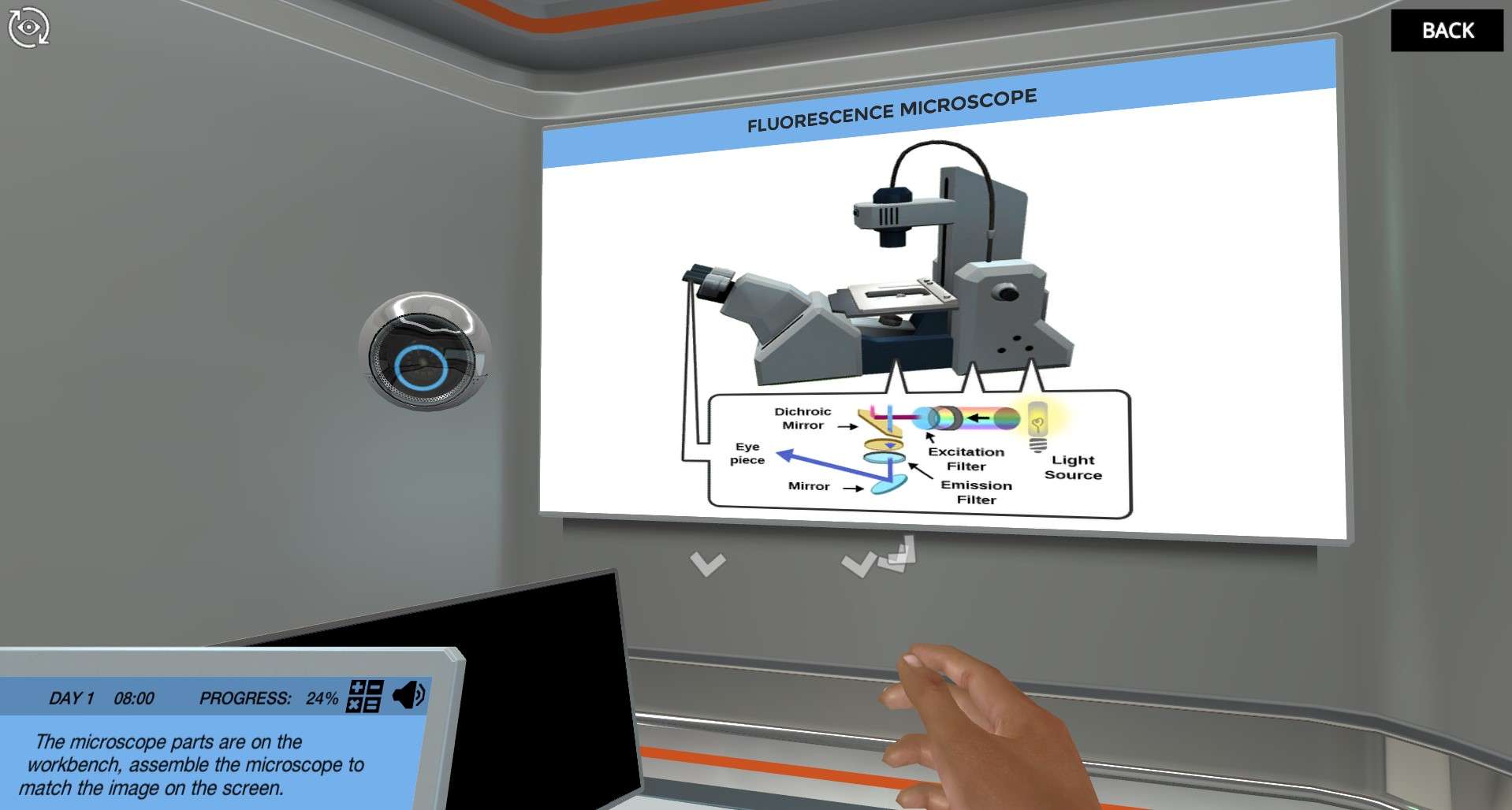Heading 1
Heading 2
Heading 3
Heading 4
Heading 5
Heading 6
Lorem ipsum dolor sit amet, consectetur adipiscing elit, sed do eiusmod tempor incididunt ut labore et dolore magna aliqua. Ut enim ad minim veniam, quis nostrud exercitation ullamco laboris nisi ut aliquip ex ea commodo consequat. Duis aute irure dolor in reprehenderit in voluptate velit esse cillum dolore eu fugiat nulla pariatur.
Block quote
Ordered list
- Item 1
- Item 2
- Item 3
Unordered list
- Item A
- Item B
- Item C
Bold text
Emphasis
Superscript
Subscript
About This Simulation
Enter the virtual microscope room to see inside a tissue sample. Learn how a fluorescence microscope can create a high contrast image and answer biological questions.
Learning Objectives
- Understand the basic principles and practical aspects of fluorescence microscopy
- Explain the function of different parts of the fluorescence microscope
- Optimize fluorophore choice
- Describe the application and limitations of fluorescence microscopy in biology
- Understand the need for staining
About This Simulation
Lab Techniques
- Fluorescence Microscopy
Related Standards
- HS-PS1-3
- Unit 2: Ionic Compounds Structure and Properties
- 10.1 Fundamentals of organic chemistry
- 10.2 Functional group chemistry
- 20.1 Types of organic reactions
Learn More About This Simulation
This simulation, along with “Light Microscopy,” has been adapted from the original, larger “Microscopy” simulation.
Assemble the fluorescence microscope and discover how the key components help to create a high contrast image. In this simulation, you will learn how to use a fluorescence microscope to analyze an intestine tissue sample. You will discover what fluorescence is and what the applications and limitations of fluorescence microscopy in biology are. The sample has been prepared for you, your mission is to determine whether the cells in the intestine are infected with a virus.
Assemble the microscope
First, you will assemble the fluorescence microscope and discover the function of the key components. Learn how, together, the parts of the microscope can magnify the image up to 1000 times with high contrast. You will also discover how molecules called fluorophores emit fluorescent light after being brought to a higher energy state and how you can label structures of interest in your sample with these fluorophores.
Analyze the sample
The sample contains three fluorophores, each labeling a different biomolecule. Using the fluorescence microscope, you can study the localization of the virus in the tissue. Can you find out whether the cells of the intestine have been infected by the virus? Finally, you and Dr. One will compare microscopy techniques. Is the fluorescence microscope the one microscope to rule them all?
RELATED SIMULATIONS
Light Microscopy
Microscopy
For Science Programs Providing a Learning Advantage
Boost STEM Pass Rates
Boost Learning with Fun
75% of students show high engagement and improved grades with Labster
Discover Simulations That Match Your Syllabus
Easily bolster your learning objectives with relevant, interactive content
Place Students in the Shoes of Real Scientists
Practice a lab procedure or visualize theory through narrative-driven scenarios


FAQs
Find answers to frequently asked questions.
Heading 1
Heading 2
Heading 3
Heading 4
Heading 5
Heading 6
Lorem ipsum dolor sit amet, consectetur adipiscing elit, sed do eiusmod tempor incididunt ut labore et dolore magna aliqua. Ut enim ad minim veniam, quis nostrud exercitation ullamco laboris nisi ut aliquip ex ea commodo consequat. Duis aute irure dolor in reprehenderit in voluptate velit esse cillum dolore eu fugiat nulla pariatur.
Block quote
Ordered list
- Item 1
- Item 2
- Item 3
Unordered list
- Item A
- Item B
- Item C
Bold text
Emphasis
Superscript
Subscript
A Labster virtual lab is an interactive, multimedia assignment that students access right from their computers. Many Labster virtual labs prepare students for success in college by introducing foundational knowledge using multimedia visualizations that make it easier to understand complex concepts. Other Labster virtual labs prepare learners for careers in STEM labs by giving them realistic practice on lab techniques and procedures.
Labster’s virtual lab simulations are created by scientists and designed to maximize engagement and interactivity. Unlike watching a video or reading a textbook, Labster virtual labs are interactive. To make progress, students must think critically and solve a real-world problem. We believe that learning by doing makes STEM stick.
Yes, Labster is compatible with all major LMS (Learning Management Systems) including Blackboard, Canvas, D2L, Moodle, and many others. Students can access Labster like any other assignment. If your institution does not choose an LMS integration, students will log into Labster’s Course Manager once they have an account created. Your institution will decide which is the best access method.
Labster is available for purchase by instructors, faculty, and administrators at education institutions. Purchasing our starter package, Labster Explorer, can be done using a credit card if you are located in the USA, Canada, or Mexico. If you are outside of North America or are choosing a higher plan, please speak with a Labster sales representative. Compare plans.
Labster supports a wide range of STEM courses at the high school, college, and university level across fields in biology, chemistry, physics, and health sciences. You can identify topics for your courses by searching our Content Catalog.















